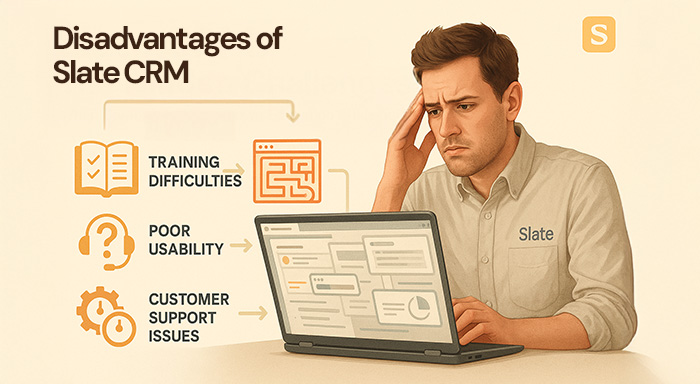Contemporary institutions are looking for tools that centralize processes across marketing, admissions, and alumni relations. CRMs have played a crucial role in the industry of higher education. Ranging from managing student inquiries, enhancing administrative efficiency, to simplifying process and offering data-driven insights, the use of CRM in higher education is immense. In this blog, we will discuss one of the CRMs most used in higher education, i.e., Slate CRM. Is it better than Element 451? You will get all the insights you need to make the best choice for your school.
What Is Slate CRM?
Slate is a web-driven admissions and CRM platform created by Technolutions. It covers the entire lifecycle of a student ranging inquiry and applications to admissions and student’s progress. Furthermore, it also incorporates post-graduation engagement of students to help the school maintain strong relationships with its alumni. Slate provides support for text, email, forms, application reviews, etc. Users can access all the features via a web browser. This simplifies workflow across all departments and teams.
Slate enjoys a worldwide popularity in streamlining workflows of modern institutions. It already serves 1,000+ universities and colleges and is reputed quite highly in terms of simplifying admission workflows.
What Are the Pros and Cons of Slate CRM?
The core strengths of this CRM platform exist in its comprehensive suite of features and the ability to centralize complex processes. However, it also has its fair share of disadvantages such as the need for initial training and usability problems that can impact teams.
Benefits of Slate CRM

High Personalization: You can tailor the CRM and add functionalities to make it aligned with the unique needs of your institution.
- Complete Features: It provides an extensive and robust toolkit for managing a student lifecycle.
- Simplified Admissions: The CRM centralizes distinct processes into a centralized system, enabling institutions to make their admission process a lot simpler.
- Marketing Automation: It provides access to effective tools for tailored and automated marketing campaigns via SMS or email text.
- Comprehensive Reporting and Analytics: The platform supports reporting with built-in tools, predictive modeling, and data visualization.
Disadvantages of Slate CRM

- Need for Training: This CRM for higher education institutions involves a steep learning curve. Both beginners or even experienced CRM users can require cheat sheets or rigorous training initially.
- Poor Usability: The navigation is not that simple. Users report going through several clicks or tabs to get the information they need.
- Average Customer Support: If you go through customer testimonials, you will find that users are not too happy with the Technolutions’ customer support. Instead of direct support, users are asked to refer to knowledge bases, videos, or forums.
- Implementation Challenges: The heavy customization directly impacts implementation which, as some users report, can take years. Users must create their Slate CRM instance, which can be quite time-taking.
Timeline of Slate CRM Implementation
Implementing a Slate CRM is a challenging and a multi-year process that requires great expertise. The institutions that successfully adopt this CRM implement a structured approach involving 3 phases:
- Phase 1 (Year 1-2): In the first phase, you deal with configuring the application, events, application review workflow, and request data forms. If you can implement these features successfully and quickly, then you can simplify your admission process greatly. Furthermore, these features are central to the overall value provided by Slate.
- Phase 2 (Year 2-4): Once your team is comfortable with the basic functionality of admission and event process. Colleges generally create Slate portal pages to simplify numerous steps in admission process, enhance e-mail communication flows, boost segmentation, and better the HTML design marketing materials.
- Phase 3 (Year 4+): More sophisticated features leveraging customization on ping/pong functionality and portal pages.
What Are the Alternatives to Slate CRM?
Now, since you know the various demerits and challenges that come up during Slate CRM implementations, it is wise to search for its alternatives. In this list, let us list out its main alternatives:
Element 451:
It is an advanced, modern, and AI-powered CRM specialized for enrollment management and higher education admissions.
The main features of the platform are as follows:
- Centralized Management of data.
- AI-driven Bolt Agents for engagement of students.
- Real-time analytics for decision-making.
- Automated status updates and follow-ups.
- Mobile-responsive design.
Salesforce Education Cloud:
It is a powerful, customizable, and feature-packed CRM platform offered for educational institutions of distinct sizes.
The main features are listed as follows:
- Robust automation tools.
- Complete management of student journeys.
- An extensive ecosystem of third-party integration.
- Sophisticated capabilities and AI analytics.
- Highly personalizable workflows.
LeadSquared:
With its complete set of tools for admissions management, LeadSquared is one of the core competitors of Slate CRM. The high scalability and flexibility of the platform differentiate it from the rest.
The main features of the platform are listed as follows:
- Sophisticated lead management.
- End-to-end automation of admission.
- Mobile-first approach.
- Complete marketing tools.
- Integration capabilities.
- Powerful analytics and reporting.
Zoho CRM:
It provides an affordable and flexible CRM solution that can be customized to suit educational institutions.
The key highlights of the platform are as follows:
- Account-based marketing.
- Line integration.
- WhatsApp for business integration.
- Advanced reporting.
- Zia AI improvements.
- Personalizable pipelines and workflows.
Slate CRM Vs Element 451: An Overview
Configuration and Admission Workflows
Slate provides a centralized and robust admissions toolkit- applications portals, forms, evaluations, events, and communications, all centralized within a single platform. Its versatility enables institutions to personalize components to specific workflows such as community college pipelines or graduate workflows. However, achieving a smooth integration needs considerable configuration, technical know-how, and custom rule designs. Your team must set up the workflows; it does not have any in-built configuration for specific workflows.
On the contrary, Element 451 provides an AI Workforce for Higher Ed- a suite of advanced tools specialized to perform out-of-the-box tasks. Irrespective of whether it is related to simplifying inquiries, scheduling events, or processing applications, it provides agents that are tailored for higher education workflows. The main advantage of adopting this tool is the fact that you do not have to create logic from absolute basic. This allows staff to focus on their own tasks instead of building codes for configuring systems.
Automation, AI, and Agents
In recent times, Slate has ensured significant improvements to its platform through AI integration, positioning itself among the best AI CRM tools available today. New features include AI dashboard insights, Reader AI for document summarization, voice message generation, AI rules, etc. Users have appreciated the inclusion of these productivity tools, but the problem is that these tools help the staff instead of performing tasks autonomously. Slate is essentially a CRM; you will have to initiate the tasks, and the platform will just record and support.
Element 451 is quite the opposite of Slate and adopts total automation. It offers tools that autonomously execute tasks, not just in creating content, but also implementing campaigns, scoring applications, tracking progress of students, and automatically responding to inquiries. With Element 451, users can leverage an instant layer of automation. There is no need for training or building codes, the teams can deploy the platform and ensure complete automation.
Engagement Across Multiple Channels-
Slate provides support to forms, emails, text messaging, and portals. It does centralize application touchpoints quite efficiently. However, there are other channels like dynamic microsites or chats that might need more development or additional tools.
On the contrary, there is omni-channel integration in Element 451, incorporating live chat, SMS, voice, email, etc. These are all managed by agents that ensure real-time and customized conversations. Adopting Element 451 can help you ensure that your enrollment team remains modern and responsive. You do not have to spend more effort, weaving tools or improving functionalities.
Speed to Value and Integrations-
Slate offers the facility of integration, helping institutions combine SISs, ERPs, admission services, testing feeds, etc. However, the disadvantage is that the integration project can go on for months and maybe years. Institutions iteratively establish their ecosystems.
In Element 451, there are pre-built connects and considers integrations as triggering instance for its AI workforce. For example, after a student submits an event form, AI Workforce can launch a confirmation agent and follow-up campaigns. This instantly reduces the implementation cycles, bringing it down to weeks from months. Thus, this expedites content delivery to enrolled students.
Adoption & User Experience-
The dashboard of Slate is quite dense and robust. It can be slightly tricky for the beginners, who will need initial training to be familiar with the interface. In a lot of campuses that use Slate CRM, you will see a “Slate Captain” that will take care of configurations and provide technical support to the users.
Element 451 ensures smooth onboarding courtesy of its user-friendly interface. It easily allows the staff to review drafts of agents, approve flows, and track performance without requiring technical background. Its simple interfaces improve its adaptability across admissions, marketing, and student success team.
Data Analytics and Insights-
The reporting system of Slate CRM is quite sound- funnel analytics, reply monitoring, dashboards, profile charts, etc. A robust reporting system becomes useful for overall operational visibility, though in-depth insights generally need external BI tools.
Element 451 focuses on agent-driven metrics. It takes care of indicators like conversations handled, applications forwarded, Return on Investment on Campaigns, and student risk alerts. There is no need for external BI tools, all the features are available within the platform. Users can derive valuable recommendations based on data analytics. This improves strategy making at a higher level.
Market Landscape:
Slate’s popularity pervades all across the higher education industry. It holds a staggering 55% of the market share as per the 2025 data. Experts consider Slate to be a safe choice for institutions having a strong technical team.
Currently, the market share of Element 451 is around 25%, but it is growing quite steadily. It has positioned itself as an advanced AI workforce for higher education institutions. Its usefulness goes beyond standard CRM and caters to institutions looking for scalable, modern, and student-oriented engagement without IT heavy lifting.
Conclusion
Slate CRM has attained a great reputation in the market as a go-to platform for higher education institutions looking to simplify admissions and student engagement processes. Its vast customization options, extensive range of features, and reporting functionalities make it a preferable choice for universities with great tech support. However, it also has a few disadvantages such as multi-year implementation, steep learning curve, and lack of smooth usability. For institutions looking for a quicker, AI-based, and automation-centric solution, alternatives such as Element 451 have grown in popularity due to minimum complexity and higher agility.
FAQs for Slate CRM
Q. Which is the most popular CRM for schools and colleges?
A- Slate emerges as the popular choice among higher educational institutions with 55% market share.
Q. Is Slate used in United States?
A- Yes, universities in the US leverage Slate to simplify their admissions, improve students' engagement, and enhance their alumni programs.
Q. Which tool is best in terms of reports and analytics: Element 451 or Slate CRM?
A- It depends on your institutions’ workflows and needs. Slate CRM provides funnel view and real-time analytics, which is ideal for operational reporting. In Element 451, you get outcome analytics in real-time. Such analytics are directly associated with agentic actions. Thus, Element 451 provides a better strategic viewpoint.
Q. Name the top universities that use Slate CRM?
A- The best universities in the US use Slate. For example, Johnson & Wales University, California State University, University of Virginia, Duke university.
Q. Who are the top competitors of Slate CRM?
A- Though Slate CRM occupies a large market space, it faces stiff competition from Element 451, Salesforce, Zoho, LeadSquared, etc.



.png)

.png)
.png)

